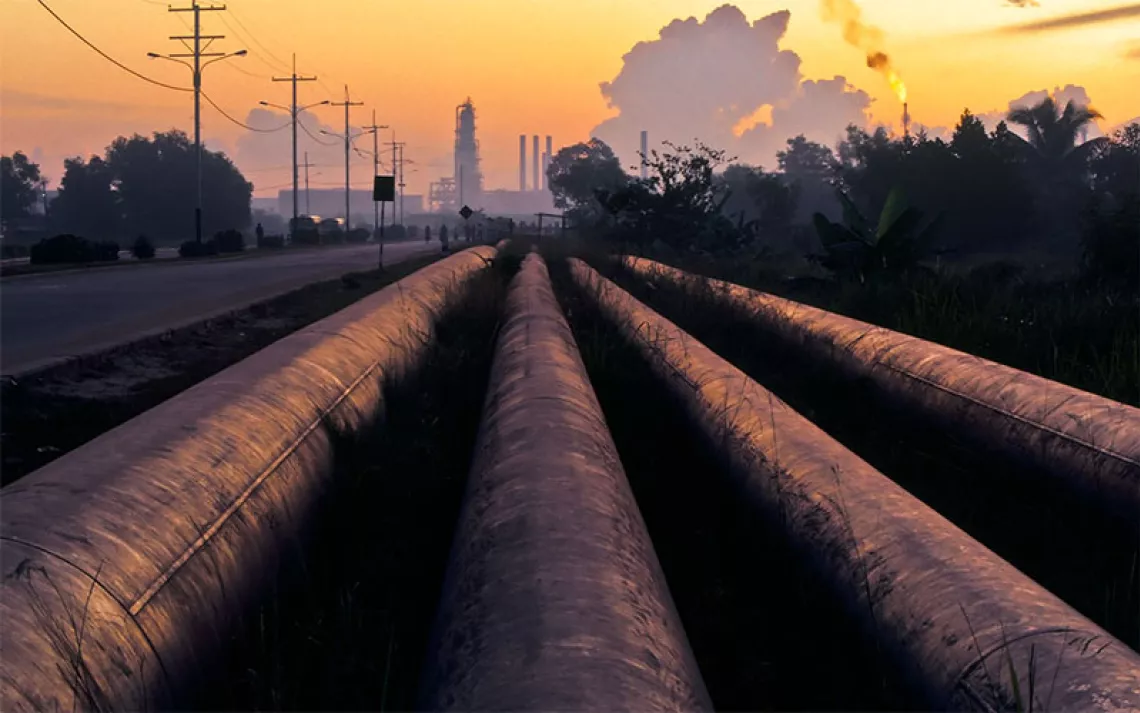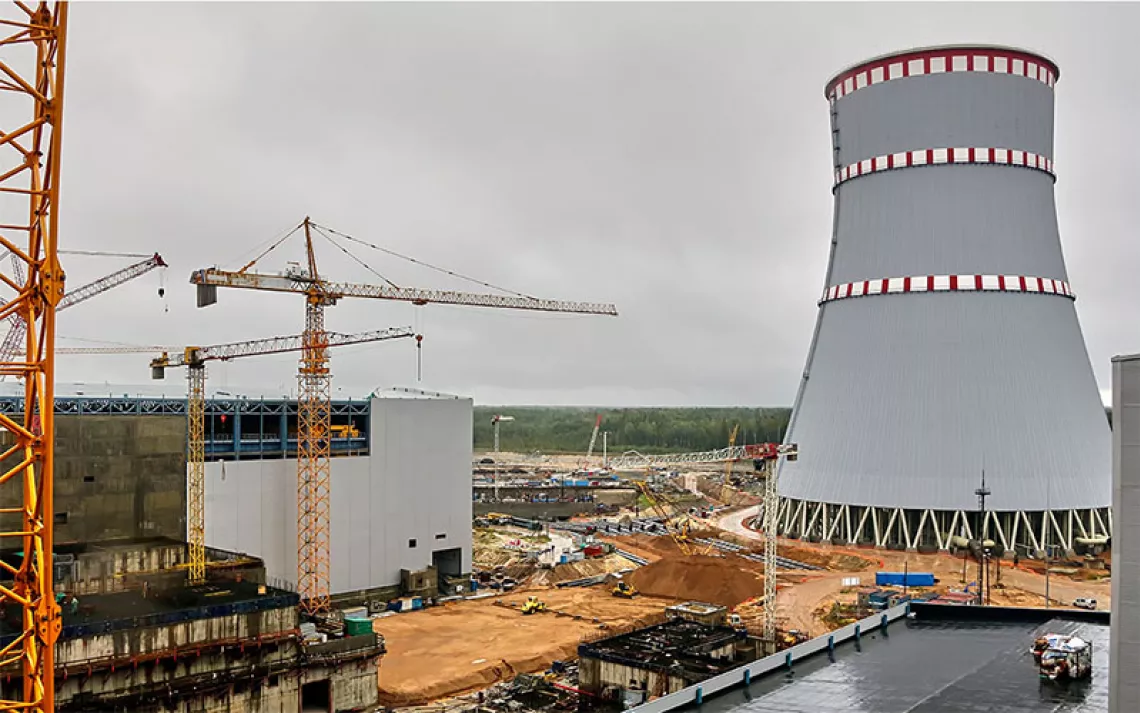The Fossil Fuel Industry’s Spin on High Energy Prices Is BS
A faster shift to renewable energy, not a slower one, could save the US billions of dollars

Photo by istock/ronniechua
You’ve probably noticed that the price of gasoline has been edging up for much of this year. Depending on where you live and how you heat your home, your utility bills may be on the rise too.
When Americans hit the roads for the recent Thanksgiving holiday, the cost to fill up their cars was at a nine-year high. The US Energy Information Administration expects the average US household that uses heating oil to warm their homes will pay 43 percent more this winter, compared with last year. Meanwhile, the price of crude oil has surged more than 60 percent and coal prices have more than doubled. Natural gas prices in the United States are twice as high as they were at the start of 2021, but even that pales in comparison to the eye-watering price increases in Europe and Asia.
The rise in energy prices is becoming a political issue, as President Joe Biden’s approval ratings go lower as fuel costs go higher. Fossil fuel interests—no doubt smelling blood in the water—are increasingly trying to pin the blame on the administration. But experts say that the industry spin is a calculated attempt to connect completely separate issues as a way of forestalling action on climate change. In reality, the volatility of oil and gas prices underscores the urgent need to shift away from them.
During the past few months, oil and gas lobbyists have waged a full-court press to kill the Build Back Better Act, the sweeping social safety net and climate investment package under negotiation in Congress. Among other things, the proposed legislation would impose fees on methane emissions, potentially eliminate fossil fuel subsidies, and dramatically accelerate the shift to renewables by investing hundreds of billions of dollars in clean energy.
Central to the oil industry’s strategy has been an attempt to link high energy prices and inflation to the Biden administration’s climate policies. Not enough drilling, too many regulations, and too much focus on climate change are the reasons why Americans are paying more to fill up their gas tanks and heat their homes, industry propaganda says. The expression “greenflation” has become commonplace in energy and financial industry circles, and has become shorthand for indicting the growing international push to address climate change.
In November, as gasoline prices rose, the CEO of Pioneer Natural Resources, Scott Sheffield, said that President Biden should “back off” of the oil industry, and that his attempts to put restrictions on drilling on federal lands “have been starting to backfire some.”
But many experts say that framing is cynical opportunism. “It's all bunk,” Clark Williams-Derry, an energy finance analyst at the Institute for Energy Economics and Financial Analysis, told Sierra. “There is no justification for saying that high global oil prices are the result of the US not leasing a certain amount of acres. There's no connection between those things. It doesn't make any sense.”
There are so many factors behind the global increase in oil and gas prices, but “almost none of them have to do with US policy,” he said.
Williams-Derry pointed to the price spikes for an array of other commodities that have nothing to do with energy policy—copper, rubber, meat, lumber, iron ore, used cars, and semiconductors, to name just a few. Moreover, the entire world is suffering from these price swings, not just the United States.
The common thread in every sector experiencing rising prices is, unsurprisingly, the pandemic. “Any analysis of today's commodity price volatility that ignores COVID is just plain stupid, and should be written off immediately,” Williams-Derry said.
The story by now is familiar. The global economy went into hibernation for a period at the beginning of the pandemic, and that meant supply chains were disrupted. Those impacts are still being felt. At the same time, oil prices plunged into negative territory, bringing financial devastation to the oil industry.
But poor returns did not start with COVID-19. “Remember, the oil industry, at least in the US—it was a sea of red ink for the entire fracking era,” Williams-Derry said. The US shale industry burned through over $300 billion in the decade preceding the pandemic. Oil executives are eager to blame climate policy, but fracking is a business model that has not yet proven to be financially sound.
That is important because oil production is not rebounding even though prices have recovered. Investors, wary of the fracking industry’s dismal track record, are now keeping oil companies on a very tight leash, punishing those that spend money on new drilling. As a result, hundreds of drilling rigs remain idled.
A litany of other factors are also contributing to high energy prices. China curtailed coal production for reasons of safety and industry corruption. Extremely cold weather last winter depleted energy stockpiles in China and North Asia, contributing to tighter conditions heading into this winter. And climate-fueled disasters have disrupted energy supply around the world: Drought has curtailed hydropower in California and Brazil, while Hurricane Ida knocked oil and gas production offline in the Gulf of Mexico for several weeks.
Further blame can be pinned on big oil and gas producers themselves. OPEC+, a group of oil producers dominated by Saudi Arabia and Russia, have kept millions of barrels of oil production capacity offline for the past year and a half, which has pushed up oil prices worldwide. Meanwhile, a noticeable drop in Russia’s exports of fossil gas to Europe beginning in August led to historic price spikes. The UK in particular has suffered from record surges in gas prices, which has bankrupted at least 20 energy companies in recent months.
At an energy industry conference on November 30, the head of the International Energy Agency, Fatih Birol, listed several factors for rising global energy prices, pointing to supply outages, extreme weather, and pandemic disruptions. “[B]ut also—I want to underline this—some of the deliberate policies of energy producers” are also driving up prices. He added that climate policy is not to blame.
These global developments ripple back to the United States, which is exporting more gas than ever before. Even though there is no shortage of fossil gas domestically, and demand is not rising, the fact that more and more gas is shipped overseas means that the United States is increasingly exposed to global market volatility. The country went from exporting very little gas five years ago to exporting 10 percent of the gas it produces today. As a result, US consumers are seeing rising prices. As Williams-Derry wrote in a recent report, the United States “is exporting natural gas and importing price volatility.”
The oil and gas industry and some of its financial backers have also tried to seize on high energy prices as a reason to slam the brakes on international climate policy, and their overwrought warnings hit a fever pitch as the UN-sponsored climate negotiations got underway in Glasgow in November.
“If you try and raise money to drill holes, it’s almost impossible to get that money,” lamented Stephen A. Schwarzman, CEO of the private equity giant Blackstone, while at a conference in Saudi Arabia in late October ahead of the climate talks. He warned there would be “real unrest” around the world if global capital starved the fossil fuel industry and shifted too quickly toward a clean energy transition.
Other industry watchers disagree. “I would argue the exact opposite. We are not going fast enough” said Cara Bottorff, senior electric sector analyst at the Sierra Club, referring to industry-backed claims that the clean energy transition is going too fast.
She pointed to a recent forecast from the US Energy Information Administration, which finds that while the average American home that uses electricity for heating could see its bills rise by between 4 and 15 percent this winter, those homes that use fossil gas for heating could see bills jump by as much as 50 percent.
“If we were going faster, we would have a lot more of these electrified end uses that would make us less dependent on gas, and we wouldn't have to be hamstrung by this volatility,” Bottorff said.
The lesson can be applied to other energy systems, including transportation. If the United States aggressively tried to speed up the energy transition to break oil dependence, “you wouldn’t have, ‘Surprise! This year somebody in Saudi Arabia decided not to drill and now we're all screwed.’” Bottorff said. With clean energy and electrification, “you can avoid that,” she said. As Transportation Secretary Pete Buttigieg told MSNBC in late November, families who buy electric vehicles “never have to worry about gas prices again.”
In mid-November, the IEA’s chief economist, Tim Gould, testified at a Senate Energy and Natural Resources committee hearing during which West Virginia senator Joe Manchin asked him which countries in Europe have fared better than others amid soaring prices. “The countries that had the lowest increase in electricity prices over the past few months … were countries that had invested heavily in renewables in the Nordic states of Europe,” Gould said.
Moreover, the impact on energy prices from many climate policies is deflationary, not inflationary, according to Williams-Derry. “Our green policies, they tend to be things like subsidies for electric vehicles. That's one major green policy we've got. The result is actually a decrease in [oil] demand. Which leads to lower prices,” he said. “Another concrete policy is a renewable portfolio standard that's actually leading to increases in renewable power. Which is eating into demand for fossil fuels in general.”
The $550 billion in subsidies for electric vehicles and renewable energy tucked into the Build Back Better Act, now at the mercy of Senator Manchin, would scale up and accelerate this push to clean energy. That legislation may not help with the current predicament, but it would add huge amounts of new clean energy that would lower prices in the medium and long term.
A recent study from the nonprofit RMI found that the Build Back Better framework could save both utilities and ratepayers $9 billion by the end of the decade. The benefits were widespread—coal-heavy West Virginia stands to gain $430 million in energy savings from the sweeping climate programs in the Build Back Better Act, while Texas could see $584 million in savings.
Of course, this is exactly why the oil industry is fighting like hell to kill it, opportunistically latching onto unrelated price swings in commodity markets. “Opponents of the Build Back Better proposal have repeatedly amplified the myth that the financial incentives for clean energy will burden Americans with higher electricity costs,” the authors wrote. “But a new RMI analysis shows the opposite to be true.”
The industry-favored approach of a drill-everywhere market free-for-all—summed up as “energy dominance” during the Trump era—keeps the US economy trapped on the boom-and-bust roller coaster that is endemic to fossil fuels.
“The problem we have is not greenflation. The problem we have is fossil fuel dependence. It's the flip side of what everybody is talking about,” Williams-Derry said. “A fossil-fuel-based economy is fundamentally driven by volatility.”
“The only way off this roller coaster, this fossil fuel roller coaster, is to move to commodities that aren't so volatile,” he added. “And the only commodity that we've got that we know is going to be free is the sun and the wind.”
 The Magazine of The Sierra Club
The Magazine of The Sierra Club



